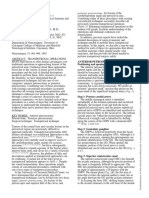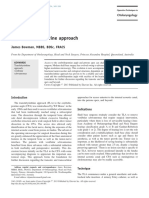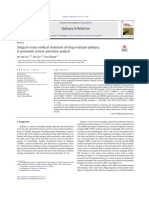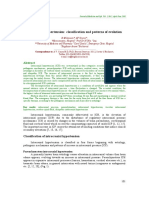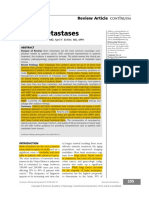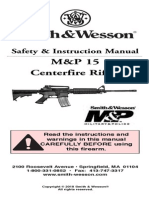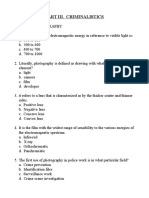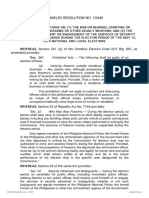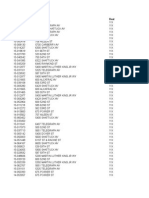Jandial2008 PDF
Jandial2008 PDF
Uploaded by
SebastianCopyright:
Available Formats
Jandial2008 PDF
Jandial2008 PDF
Uploaded by
SebastianOriginal Title
Copyright
Available Formats
Share this document
Did you find this document useful?
Is this content inappropriate?
Report this DocumentCopyright:
Available Formats
Jandial2008 PDF
Jandial2008 PDF
Uploaded by
SebastianCopyright:
Available Formats
SPECIAL ARTICLE
BALLISTICS FOR THE NEUROSURGEON
Rahul Jandial, M.D. CRANIOCEREBRAL INJURIES FROM ballistic projectiles are qualitatively different from
Department of Neurosurgery, injuries in unconfined soft tissue with similar impact. Penetrating and nonpenetrating
University of California, San Diego,
San Diego, California
ballistic injuries are influenced not only by the physical properties of the projectile, but
also by its ballistics. Ballistics provides information on the motion of projectiles while
Brett Reichwage, M.D. in the gun barrel, the trajectory of the projectile in air, and the behavior of the projec-
Department of Neurosurgery, tile on reaching its target. This basic knowledge can be applied to better understand
University of Florida, the ultimate craniocerebral consequences of ballistic head injuries.
Gainesville, Florida
KEY WORDS: Ballistics, Brain, Gunshot, Injury, Projectile, Trauma
Michael Levy, M.D., Ph.D. Neurosurgery 62:472–480, 2008 DOI: 10.1227/01.NEU.0000297046.66788.89 www.neurosurgery-online.com
Department of Neurosurgery,
University of California, San Diego,
San Diego, California
B
allistics has been identified as the “sci- evolution of firelock, matchlock, flintlock, and
Vincent Duenas, B.S. ence of the motion of a projectile through wheel lock muskets. There was a slow but
University of San Diego College
a gun barrel, subsequently through a consistent progression toward guns with
of Medicine medium such as air, and eventually into or faster and more accurate bullets. Initially,
San Diego, California through a target” (33). However, ballistics is firearm projectiles were lead balls, hand-
not only associated with bullets. The motion of loaded through the muzzle. Muzzle-loading
Larry Sturdivan, B.S., M.S. any body in unpowered flight is that of a bal- firearms were used for many years.
LMS Scientific Models, listic projectile. This category covers objects, Rifling, which allowed spin stabilization of
Sante Fe, New Mexico from hand-thrown objects to intercontinental nonspherical bullets, was invented in AD
ballistic missiles, at a full range of masses and 1520. The elongated bullets, still made of solid
Reprint requests: velocities. The science of ballistics is usually lead, were much more accurate than the lead
Brett Reichwage, M.D.,
4343 NW 61st Terrace,
divided into three categories: interior ballistics, balls that prevailed at the time and were still
Gainesville, FL 32606. which is particular to firearms and deals with used for centuries thereafter. Two hundred
Email: the motion of a bullet in the gun barrel; exte- years passed before jacketing or plating of
brett.reichwage@neurosurgery.ufl.edu rior ballistics, the study of the flight of a projec- the lead bullets was devised to slow the
tile through air; and terminal ballistics, which build-up of lead in the gun barrel. Cleaner-
Received, July 16, 2007.
deals with the behavior of the ballistic projec- burning propellants gradually replaced the
Accepted, September 28, 2007.
tile upon reaching its target. When the target is original black gunpowder, which dramati-
a person, the study is called wound ballistics cally slowed fouling of the gun barrel by
(1, 4, 9, 34). In addition to penetrating injuries, burned gunpowder particles (21, 34). In 1847,
wound ballistics covers blunt injury from non- Delvigne introduced elongated bullets with
penetrating ballistic projectiles and multiple a hollow base. Pressure from the burning
injuries by separate impacts from fragmenting propellant expanded the base of the bullet
munitions. Other types of injury, such as blast into the rifling grooves in the barrel, which
and incendiary effects, are not, strictly speak- helped preserve the structural integrity of the
ing, ballistic phenomena but are often studied grooves during acceleration of the bullet (Fig.
as part of wound ballistics. Of particular im- 1). In 1847, Captain Minie inserted an iron
portance for our purposes is to understand the cup into the hollow base to maintain symmet-
projectile behavior that results in craniocere- ric expansion of the bullets. These new bul-
bral injuries. lets, called “minie balls,” were muzzle loaded
Before the 14th century AD, when gunpow- into percussion muskets. From 1850 until the
der was introduced to Europe by the Mongols, turn of century, breech-loading ammunition
the majority of head injuries were caused by gradually replaced the muzzle loaders.
low-velocity objects such as sabers, swords, Bullets were “jacketed” with a hard-gilding
lances, arrows, slingshots, and hand- or metal, such as cupronickel, which lowered
machine-thrown projectiles, usually stones. friction in the muzzle in addition to reducing
The introduction of gunpowder initiated the fouling. Lowered friction and larger amounts
472 | VOLUME 62 | NUMBER 2 | FEBRUARY 2008 www.neurosurgery-online.com
BALLISTICS FOR THE NEUROSURGEON
FIGURE 1. Cross-sectional and oblique views of a rifle
bore. (Used with permission from www.hunter-
ed.com.)
of more efficiently burning propellant resulted in a substantial
velocity increase to 2000 ft/s (615 m/s) or more (1, 22). After
the Hague Convention of 1889, military bullets were required
to be fully jacketed at the tip. For efficient, automated assem-
bly, these are left open at the base. Much hunting ammunition
continued to have open-tip jackets that are solid across the FIGURE 2. Comparative photograph showing the size
base of the bullet (closed base). differentials of commonly used calibers. (Kalkomey
The introduction of gunpowder around the world also gave Enterprises, Inc., 2006. Used with permission from
rise to explosive, fragmenting munitions, such as grenades www.hunter-ed.com.)
and artillery ammunition. The explosive element in such
munitions soon evolved into a variety of higher-powered
explosive compounds. As these made their way into industrial Common firearm and ammunition calibers include .17, .22,
uses, the number of injuries from accidental industrial explo- .25, .223, .30, .38, .44, .45 (calibers in inches) and 5.56, 7.62, and
sions soon outpaced military action and hunting accidents as 9 mm. Weapons are made in other calibers, but these are less
a cause of the injuries with which we are concerned. From common in the United States.
the beginning, however, the contribution of military-based Handguns include revolvers and semiautomatic pistols.
scientific studies into the causes and treatment of craniocere- Revolvers are usually cheaper, more reliable, more accurate,
bral injuries was disproportionate to the proportion incurred and easier to master than their semiautomatic counterparts.
as casualties of war. However, whereas a semiautomatic can hold up to 19 rounds,
a revolver usually has a six-round capacity. Semiautomatics
use the recoil produced from a fired round to eject the spent
FIREARMS AND AMMUNITION cartridge case, load the next cartridge, and cock the hammer,
whereas revolvers depend on the shooter to advance and fire
Firearms the next round. In addition to using a more complicated mech-
Firearms that can be wielded by a single person include anism for firing and reloading, semiautomatics often use
handguns, rifles, and shotguns. Firearms can be subclassified smaller propellant charges and drain some energy from the
based on their type of action, defined as the way a cartridge propellant to operate the mechanism, which lessens their
is loaded, fired, and expelled from the firing chamber, and power relative to a revolver (14).
may incorporate a bolt, pump, lever, revolving cylinder, semi- Although longer and heavier than handguns, and more dif-
automatic, or fully automatic action. Firearms and ammuni- ficult for a criminal to conceal, rifles offer greatly increased
tion also come in different calibers. Caliber is the diameter of accuracy and power and are easier to use and more accurate
the firearm bore (inside of the barrel), measured from land to than handguns. Semiautomatic rifles and handguns have a
land (a land is the interior metal surface of the bore between similar mechanism of action, but the rifle has a much stronger
the rifling grooves) and expressed in fractions of an inch or firing chamber to withstand the greater pressure that accompa-
millimeters (Fig. 2). Caliber is a nominal term, however, as nies a larger propellant charge and a longer barrel. Lever
some do not correspond to the actual bore or bullet diameter. action, bolt action, and single-shot action are generally found in
Ammunition is constructed to fit into a specific firearm. more powerful hunting rifles.
NEUROSURGERY VOLUME 62 | NUMBER 2 | FEBRUARY 2008 | 473
JANDIAL ET AL.
Shotguns also have long barrel lengths but almost univer- Center-fire Rifle Ammunition
sally lack rifling. Thus, the shotgun is known as a smoothbore. The range of sizes and powers of rifle cartridges is even
Although the weapon is also known as a scattergun, the pres- wider than that of handgun rounds. They range from .17 to .700
ence of rifling in a shotgun would impart a spin that would caliber, and the most common calibers are .223 (Fig. 3) and .30.
exaggerate the scatter of the shot to near uselessness. Gauge is Big-game rounds, ranging up to .70 caliber and 1000 grains
the term used for the diameter of the shotgun barrel; the larger mass, are rare and should sel-
the gauge, the smaller the bore diameter. They fire a number of dom be encountered. In fact,
(usually) spherical shots from a single cartridge. The number of high-energy rifle bullets are
shots is determined by the cartridge, not the weapon. Shotguns so lethal that the neurosur-
are available in single shot, double barrel, pump, or semiauto- geon will see few brain in-
matic actions (14). The most popular shotgun is the 12 gauge, juries caused by them. If they
but 410, 20, 28, and 10 gauges are also common. are seen, most will be acci- FIGURE 3. The shape and size of
Ammunition dental hits from very distant .223 caliber ammunition. (Used
ranges or ricochets striking at by permission of Corbin Manu-
Jacketed bullets have a lead core with a metal covering that equally low velocities. facturing.)
is usually a copper alloy but may also be mild steel or alu-
minum. The lead core may include a steel insert to give the bul- Shot Shells
let better hard-target penetration. Open-tip bullets may have Shotgun ammunition varies widely, depending on the pur-
either a soft point or a hollow point. The typical soft point is a pose for which the gun is to be used (Figs. 4–6) (30). The spher-
rounded lead tip, whereas the hollow point lives up to its ical shot cannot be packed to provide a seal for the propellant
name, having a small conical hole in the bare lead. Jacketed gases in the chamber and muzzle, so a seal is provided by
bullets are reputed to be more likely to ricochet than their “wadding,” consisting of a plastic seal that contains most of the
unjacketed counterparts (29). propellant gases behind the shot to maximize the muzzle veloc-
Small Rounds and Rimfire Cartridges ity (Fig. 4). The wadding is expelled with the shot and, at short
range, is a ballistic projectile in its own right. In addition to shot
The smallest projectile is the copper-plated steel BB, which pellets, there is also slug ammunition, which is generally a solid
would not penetrate the cranium of any but the smallest infant. core of lead encapsulated in radiolucent plastic with rifling inte-
Slightly more powerful lead pellets in the same .177 caliber are grated into the plastic to spin the round to give the slug flight
only slightly more hazardous, mostly to the eye. Neither con- stability. Shot shells are constructed for each gauge, and shells
tains metals different from those found in other ammunition. of each size can be filled with different-diameter shot (33).
Rimfire cartridges are used in handguns, primarily target pis-
tols, and light rifles. Rimfire cartridges contain primer within
the rim. The .22-caliber rimfire bullet is .22-inch in diameter and
weighs from 28 to 40 grains or 3.25 g. The rounds are unjack-
eted and usually have a hollow point, and the muzzle velocity
of the long rifle cartridge, when fired from rifles, is about 1000
ft/s. The lower-power rimfire rounds have lower velocity. All
sizes have a much smaller muzzle velocity when fired from
handguns.
Center-fire Handgun Ammunition
A center-fire cartridge is one in which the primer is located
in the center of the cartridge case head. These cartridges,
used in semiautomatic pistols and revolvers, fire bullets that
range from .25 to .45 caliber (nominal diameter in inches)
with a variety of bullet weights and nose configurations in
each size. The most popular sizes were once divided accord-
ing to the group that used them. United States law enforce-
ment carried the .38 revolver, the United States military pre-
ferred the .45 automatic, and Europeans used 9-mm pistols.
This has now changed, although these are still among the
most common calibers found in the United States. Other FIGURE 4. Shotgun ammunition schematic showing
the relationships between the primer, gunpowder, wad,
common ammunition includes .25- and .32-caliber cartridges.
casing, shell, and both shot- and slug-type projectiles.
Several other calibers are less commonly encountered. Some, (Kalkomey Enterprises, Inc., 2006. Used with permis-
such as .40 caliber and 10 mm, are virtually the same size, but sion from www.hunter-ed.com.)
neither round will fit weapons made for the other.
474 | VOLUME 62 | NUMBER 2 | FEBRUARY 2008 www.neurosurgery-online.com
BALLISTICS FOR THE NEUROSURGEON
FIGURE 5. Examples of the various shapes of shotgun
slugs. (Used by permission of Corbin Manufacturing.)
FIGURE 7. Less-than-lethal bean-bag ammunition.
(Used by permission of Corbin Manufacturing.)
Other Exotic Ammunition
Explosive bullets are designed to explode on impact. This
effect is achieved by adding an agent such as lead azide at the Projectiles from Explosive Munitions
front of the cartridge. Swan and Swan (33) point out that these and Accidental Explosions
bullets often fail to explode and may pose a threat either to the Explosive bullets, such as the devastator round, are designed
surgeon during débridement or to the pathologist during to detonate on impact and, thus, will produce extensive tissue
autopsy. It would be difficult, however, to distinguish, on the injury with the additional risk of a contaminated wound.
usual hospital x-ray, between the explosive round that did not Bullets are not the only missiles that can cause a penetrating
detonate and the hollow-point bullet that did not deform. craniocerebral injury. For example, fragments from explosive
Rubber and plastic “less-than-lethal” ammunition is often used munitions weighing only 1 to 2 g caused most fatal brain
in the United States by Special Weapons and Tactic teams and injuries in Vietnam (M.E. Carey, unpublished data from analy-
for riot control to decrease the risk of injury (Fig. 7). However, sis of casualties surveyed by the Wound Data and Munitions
neither rubber nor plastic ammunition is radiopaque, and Effectiveness Team, in Vietnam). Despite their potentially dev-
therefore, neither can be seen on most diagnostic imaging in the astating effects, individual shell and grenade fragments are
unlikely event that they penetrate (26, 33). usually not as damaging as a bullet. For small pieces of shrap-
nel to cause death or serious
injury, the casualty must be
relatively close to the source
of the explosion. This is be-
cause the fragments are irreg-
ularly shaped, usually have
small mass, and have high
aerodynamic drag, so they
tend to lose velocity and
kinetic energy quickly in air.
Over the years, however,
the vast majority of non-
firearm ballistic injury to
civilian populations has not
been from either truck bombs
or fragmenting munitions,
whether military or impro-
vised, but rather from acci-
FIGURE 6. This diagram shows the diameters of the various shot and buckshot ammunition available. (Kalkomey dental explosions. These
Enterprises, Inc., 2006. Used with permission from www.hunter-ed.com.) range from domestic and
public building explosions
NEUROSURGERY VOLUME 62 | NUMBER 2 | FEBRUARY 2008 | 475
JANDIAL ET AL.
caused by gas leaks to detonations in grain elevators, refiner- atively recent myths such as “hydrostatic shock.” Since the
ies, mines, port facilities, and other environments in which beginning of the 20th century, different experimental methods
explosive mixtures can accumulate. were used to demonstrate the destructive power of bullets on
tissues. In 1915, Sir Victor Horsley observed a temporary cav-
ity in clay 30 to 40 times the diameter of the missile. In 1941,
INTERIOR AND EXTERIOR BALLISTICS Black et al. (2) used 20% gelatin to study temporary cavity for-
When dealing with bullet wounds, the surgeon will not gen- mation in gelatin by high-speed photography. The modern era
erally be able to reconstruct the details of the bullet’s interior of serious physical modeling began with the Department of
and exterior ballistic behavior before impact from the appear- Defense contract with Princeton University during World War
ance of the wound and projectile. For the reader who wishes to II. A summary of their modeling results is published in Chapter
gain a more thorough background on these topics than is pre- III of reference 100, along with a number of contemporary
sented in an article such as this, there are many good books and wound ballistics articles. Beginning in the late 1940s, this
articles to be found in the technical library or on the Internet research was continued at the Army’s Biophysics Division,
(for instance, see references 17, 19, 20, 28). Edgewood Arsenal, MD.
When a bullet is fired from a firearm, it is accelerated to a In the 1950s, Biophysics Laboratory Director A.J. Dziemian
final muzzle velocity by the very rapid burning of a propellant. used a polynomial in velocity to model retardation in tissue
Ballisticians have long noted that the travel down the barrel of and a 20% gelatin tissue simulation (10). This model was
the weapon is the final stage in the manufacture of the bullet. updated for chunky grenade and shell fragments in the 1970s
Normal engraving from the rifling and minor changes in the (31) and nondeforming bullets in the 1990s (23, 24). It can be
configuration of the projectile from the accelerating force shown that the quantity of tissue damage would be propor-
(termed setback deformation) will have little effect on the wound tional to the kinetic energy deposited in the tissue by the pen-
ballistic behavior of the bullet. Occasionally, major setback etrating projectile if it were not for the well-known rate
deformation will significantly affect accuracy and terminal per- dependence of tissue damage. This rate dependence is best
formance, degrading the former and enhancing the latter. It illustrated by silicone putty. Stretch it slowly and it will distend
would be difficult, however, if not impossible, for the treating indefinitely, but stretch it very rapidly and it will snap. Tissue,
physician (or the ballistic expert) to distinguish deformation at of course, is much less rate-dependent than silicone putty, but
launch from deformation at impact. Peters (23) and Peters et al. (24) have shown that this ”rate
Rifling was most likely invented to allow elongated bullets to effect“ gives rise to a tissue damage measure that is dependent
present a smaller presented area and correspondingly lower on the size of the projectile.
drag. The spin allowed the bullet to be stabilized in flight, like All projectiles leave a (nearly vacuous) temporary cavity in
the spinning toy top, which kept the bullet oriented point-first their wake, some large and some virtually the size of the pene-
in flight. As rifled firearms gained in popularity, however, it trating missile. The cavity is present behind all projectiles in all
was soon determined that they had a dramatically increased media. In air, the collapse of the cavity is seen on spark shadow-
accuracy over smoothbores, which fired spherical projectiles. graphs as a turbulent wake. The tissue damage is not, as some-
This was because not only did the radial spin of the rifle bullet times stated, caused by the temporary cavity. Both damage and
impart no lift, but any aerodynamic lift due to asymmetric nose the cavity are caused by the outward movement of the tissue,
shape was also turned into a tight spiral by the rapid spin. The which stretches and tears the tissue. The vacuous cavity will
effective diameter of this spiral is typically less than the diam- stay open long enough for the atmospheric pressure to push air
eter of the bullet and, thus, has no effect on accuracy. inside. The inward rush of air can sweep in debris, usually parts
Besides mass, velocity, and shape, there is another character- of the clothing and dirt that were dislodged by the projectile’s
istic of the bullet that has a significant influence on its terminal impact. Of course, whatever bacteria are on this debris will also
behavior. It is the angle that the bullet’s long axis makes with enter. The temporary cavity collapses and reopens in a pulsatile
its direction of flight. This angle is termed yaw. Bullets usually fashion for a few cycles within a few milliseconds.
fly at relatively low yaw. Excessive yaw increases drag, causing At points near the tip of the advancing bullet, the pressure is
the bullet to slow faster, and decreases accuracy by increasing very high, measuring in thousands of atmospheres. It is this
the aerodynamic lift. The effects of yaw in terminal behavior pressure that Carey (5) calls juxtamissile pressure. The tissue,
are considered in the next section. which has acquired enormous radial velocity, separates from
the projectile surface, creating the temporary cavity. It is impor-
tant to note that regardless of the size of the maximum tempo-
TERMINAL (WOUND) BALLISTICS rary cavity envelope, all the energy lost by the penetrating pro-
jectile is deposited in tissue at very high strain rates. After
Penetrating Projectiles separation (cavitation), the tissue no longer interacts with the
The study of wound ballistics has a long and varied history. bullet. Thereafter, all damage in the expanding tissue is caused
For centuries, experimenters, mostly hunters, soldiers, and sur- by the radially directed kinetic energy of the tissue itself.
geons, have developed myriad explanations for the causes of The amount of tissue injured beyond its ability to recover
observed injuries, from the frictional heat of penetration to rel- depends on the strength of the tissue, the amount of prompt
476 | VOLUME 62 | NUMBER 2 | FEBRUARY 2008 www.neurosurgery-online.com
BALLISTICS FOR THE NEUROSURGEON
damage (a function of the size of the missile), the size of the
temporary cavity, and, to a lesser extent, the presence of bone
or air-filled cavities nearby. Both leakage of intracellular fluid
from injured cells and blood from ruptured capillaries will
infuse the intercellular space, causing swelling. In addition,
torn connective tissue and cell membranes will lessen the elas-
ticity of the injured tissue. These effects combine to create a
temporarily deformed quantity of tissue around the wound
track. This swollen tissue pushes outward against the elastic
tension of undamaged tissue, opening up a “permanent cavity”
and creating a back-pressure that further compromises the FIGURE 8. Hollow-point ammunition before and
blood flow to injured tissue. Compromised circulation can lead after impact. (Used by permission of Corbin Manu-
to further cell death in tissue that was not ruptured by the ini- facturing.)
tial insult. Clinically and in animal experiments, the perma-
nent cavity is seen to be filled with blood, dead tissue, and
sometimes the debris mentioned above, such as skin, dirt, or Generally, they cause tissue damage immediately below the
pieces of clothing. Primary or secondary fragments may also be site of the impact. However, blunt impacts to the head can
contained therein. result in injuries that do not resemble injuries to other areas.
As the bullet yaws, the increase in presented area and the These are discussed in the next section.
increase in drag coefficient result in a dramatic increase in the
drag force on the bullet. The force retarding the bullet is also a CEREBROCRANIAL INJURY FROM
force on the tissue. Increased retardation leads to an increased BALLISTIC PROJECTILES
rate of energy transfer to tissue, thereby increasing the severity
of the injury. Almost all bullets will be recovered either nose- Combat wounds and civilian gunshot wounds involving
forward or base-forward, however, as they will be turned to head injury will be predominantly penetrating injuries. These
align with the wound track as the temporary cavity collapses. involve small, dense, penetrating projectiles, such as bullets,
One thing that they will not do is to “tumble” rapidly end- shotgun pellets, and fragments from munitions or improvised
over-end, as stated in some of the literature (16). This is the explosive devices. In accidental explosions or large-scale terror-
unfortunate expectation created by the use of the word “tum- ist bombings, penetrating injuries are only part of the spec-
ble” to describe yaw growth. The growth of yaw in tissue trum. Blunt impact to the head can cause lethal injuries to the
explains why an entry wound (at small yaw) may be quite brain and upper cord without penetrating the cranium.
small while the exit wound is gaping and large (21). The large Between these extremes lies a continuous spectrum of interme-
exit wound is caused by the missile exiting at high yaw. diate projectiles impacting at a variety of velocities, producing
One “benefit” attributed to a hollow- or soft-point bullet is a mix of blunt and penetrating injuries. It might be difficult to
that it is less likely to exit the target with significant residual tell whether the particular intracranial lesion is due to penetra-
kinetic energy, thereby posing a smaller risk to bystanders (18, tion or rotation. As the cranial contents are much less mobile
33). However, the damage to the primary target is larger at the than other parts of the body, one should expect that the wound
same striking energy because the expanded bullet transfers track(s) would still be in the shape of a gentle curve.
most or all of its kinetic energy to the tissue and usually stops
within the body (Fig. 8). Penetrating Ballistic Injuries to the Head
Unfortunately, when an injured patient appears for treat- Although most penetrating injuries to the head involve bone,
ment, neither the physician nor the law enforcement personnel the ones of interest at present are those that penetrate the cra-
will be able to determine the exact circumstances under which nial cavity after perforating the overlying soft tissue. The pri-
the injury took place, so the information in the last few sections mary factors that determine whether the projectile will pene-
is of little immediate use to the neurosurgeon. Striking velocity, trate the cranium are the energy at impact on bone, the contact
for instance, is a function of the condition of the weapon and area between the projectile and bone, and the thickness of bone
ammunition (or the explosive device), the distance from the at the area of impact. As indicated above, the penetration of
weapon (or detonation) to the victim, yaw or orientation of the bone is a fracture event. In the case of small, dense projectiles,
projectile as it travels through the air, and other unknown or such as bullets or metallic fragments, penetration is caused by
poorly determined factors. Similar lack of information limits a punch-out fracture, leaving a crater on the inner table of the
the knowledge of mass, striking yaw, and thickness of any bar- cranium. For the larger, slower projectile, the fracture event is
riers penetrated before striking the person (including clothing). more likely to be a cantilever fracture of roughly wedge-shaped
pieces of cranium, somewhat like the fracture pattern in a crust
Nonpenetrating (Blunt) Projectiles of ice atop liquid water when a weight is dropped on it or a
Injuries caused by the blunt impact of a large projectile mov- person steps on it. Predictive models of the probability of pen-
ing at low speed are different for different body locations. etration of both types have been formulated (32).
NEUROSURGERY VOLUME 62 | NUMBER 2 | FEBRUARY 2008 | 477
JANDIAL ET AL.
The bullet that fails to penetrate the cranium is almost the cranium before the trailing projectiles would enter at nearly
always a low-velocity impact. This may be due to extreme undiminished velocity.
range, penetration of a substantial barrier before hitting the The neurosurgeon will see very few close-range direct cra-
victim (including helmets in a military setting), an old, dete- nial hits from shotguns. The vast majority will go directly to
riorated propellant charge, or a defective weapon. For most the medical examiner. Writers speak of wadding as being a
firearm projectiles that are capable of penetrating the cranium, possible penetrating projectile at very close range (3, 30). If
the remaining velocity after cranial penetration will be sub- this were to occur with a cranial shot, however, the probabil-
stantial. Unless fragmented, the projectile will usually either ity of survival to reach a medical facility is vanishingly low.
perforate, exiting the opposite table of the cranium, or be Near misses, giving rise to a few pellet hits, will behave much
stopped on the opposite side without exiting. The bullet will the same as any group of independent, penetrating projectiles.
have taken a slightly curved path between the entry point If the wadding were to hit the cranium without interacting
and final location. For the fragmented projectile, each frag- pellets to augment penetration, it would almost certainly be
ment will have described a curved path, independent of the stopped before penetrating the cranium. Even though it is
paths of other fragments, which will usually have curvature radiolucent, one should find it hard to miss the wadding
in different directions. embedded in the scalp.
The temporary cavity that is created in unconfined soft tissue Depending on the size of the weapon, the amount of choke
is greatly modified by the containment of the cranium. The to restrict spread, and the size of shot, a shotgun blast from
limited elasticity of the cranium allows little outward move- a range of a few to several meters will scatter the pellets suf-
ment of the contents that would ordinarily create a large tem- ficiently that they will behave as individual low-velocity pro-
porary cavity. Instead, the tissue is forced to close in behind the jectiles. As is the usual case with natural phenomena, these
projectile. This not only creates a large, complex pressure envi- two cases are at the ends of what is a continuous spectrum.
ronment within the cranium but also replaces the usual radial At intermediate ranges, the outer pellets might act as inde-
motion of the tissue with a curvilinear motion. The rule of pendent projectiles, while the mass toward the center exhib-
thumb is that tissue will move away from locations at high ited significant interaction. Again, most of these injuries
pressure toward locations at lower pressure. Flow patterns are would not be survivable. The cases actually encountered in
influenced by the irregular shape of the container, the path of surgery are most likely from shots at an appreciable distance
the projectile, and the presence of tough connective tissue bar- or near misses at closer range where only the outer few pel-
riers, such as the tentorium cerebelli and the falx cerebri. If the lets hit the cranium.
projectile is a bullet from a moderate- to high-power rifle, at The phenomena of tumbling and yaw are, of course, irrele-
any reasonable range, the internal pressure generated by the vant to wounding by spherical shotgun pellets and irregular
passage of the bullet will produce an explosive rupture to the fragments (33). This does not mean, however, that these projec-
cranium at a nearby point on the cranium, lateral to the trajec- tiles will penetrate in perfectly straight lines. The fragments, in
tory of the bullet. The pressure on the cranium is highest at the particular, will develop lift that curves the trajectory. Under
location closest to the point at which the bullet has deposited the right conditions, the curvature can be dramatic.
energy at the maximum rate. The past tense is used because the Projectiles with high kinetic energy are likely to transfer
explosion will happen shortly after the bullet has already enough energy to the cranium to transform bone fragments
exited. This injury is not usually survivable. into secondary missiles. This is particularly true of tangential
Brain is not a particularly strong or elastic tissue. The dam- hits that travel through the periphery of the cranium. As bone
age caused by a penetrating projectile would be expected to is twice as dense as soft tissue, the retarding force is also twice
be as great or greater than penetrating wounds of other soft as large at the same velocity and yaw. Thus, the bone and bone
tissues. The suppression of damage by the restriction of out- fragments acquire more kinetic energy than a comparable
ward movement would likely be more than offset by the length of soft tissue. The secondary missiles from these hits
added curvilinear movement of tissue, with the rupturing can be just as lethal as through-and-through hits by the same
strains it causes. projectile, despite the fact that the primary missile never enters
The major differences between bullet penetration injury and the cranial cavity. The lower energy .22 long rifle bullet and
injuries from irregular fragments from explosions or shotgun fragments with comparable energy are not as likely to create
pellets are the smaller mass and impact velocity of these projec- bone fragments with sufficient velocity to act as secondary mis-
tiles and the higher probability of multiple penetrations. The siles (33), whether from direct or tangential hits.
fragments from munitions tend to separate more rapidly than As mentioned in the last section, the confinement of the cra-
shotgun pellets do. The fragment injuries will almost always be nium minimizes the formation of the temporary cavity, so that
separate penetrations with little or no interaction between sep- the pulsatile nature of the cavity is minimal or nonexistent.
arate wounding events. Conversely, with a shotgun, a close-up However, the pressure that would create the cavity is diverted
shot will produce a mass of projectiles that tends to penetrate into shearing forces that may injure as much tissue or more
as a single object, producing much greater penetration than a than the temporary cavity would. This rapid tissue damage
single pellet could at the same impact velocity. This is particu- quickly results in contusion and necrosis (15, 27). In the absence
larly true of head injuries. The leading pellets would penetrate of significant mass effect, small-entrance bullet wounds to the
478 | VOLUME 62 | NUMBER 2 | FEBRUARY 2008 www.neurosurgery-online.com
BALLISTICS FOR THE NEUROSURGEON
head should be treated with local wound care and more exten- cause shear injury to small blood vessels and nerves that pass
sive wounds with nonviable scalp, bone, or dura should be into the cranium.
débrided before closure. In the presence of mass effect, necrotic Another complicating factor is the compartmentalization of
brain tissue may be resected, but surgical débridement of the the cerebral contents by the tentorium and the falx. The shear
missile tract has not been shown to improve outcomes (25). pattern inside these nonspherical compartments is different
The internal pressure in the brain that would create a large with every different direction of rotation. Each rotation is a
temporary cavity in unconfined tissue can result in stellate frac- combination of front to back (nodding), side to side (tilt toward
tures of the cranium. shoulder), and rotation about the spine (shaking one’s head), in
Carey (5) has reported on an in vivo feline model in which different proportions depending on the orientation of the body
the animals were wounded intracranially with missiles of vary- and the trajectory of the projectile.
ing velocity. He observed that even missiles with low energy These shear forces can cause injury in unexpected sites far
provoked respiratory effects in the animals despite the fact that from the point of impact. This injury can be caused by thrown
the missile came no closer than 2 cm to the brainstem. It is bricks, large debris from explosions, or close-range impact of
likely the shearing motion of the tissue that flows from high blunt weapons, such as rubber bullets. As is often the case, the
pressure near the projectile toward the near-zero pressure rotation injury may be produced in combination with cranial
behind the missile that propagates to some distance from the fracture and partial penetration. This makes the injury easy to
path of the projectile. He concludes that if a missile enters the miss as one concentrates on the obvious cranial fracture and
brain without severely disrupting the brain or harming an elo- local injury to the brain.
quent structure, it is most likely ordinary pressure that affects A patient with a gunshot wound to the head will tend to
the respiratory centers in the brainstem, potentially causing present in the emergency department with signs and symptoms
death. Even if a missile enters the brain without severely dis- of brainstem compression and tonsillar herniation, which
rupting the brain (and without significant mass effect) or harm- include apnea and bradycardia. The computed tomographic
ing an eloquent structure, respiratory arrest may still occur scan may be only mildly abnormal and show no signs of
from brainstem dysfunction. He distinguishes between this expanding mass, midline shift, or edema (6, 27). It is the sudden
kind of immediate threat to life and the problem of longer- increase in intracranial pressure caused by the temporary cavi-
term neurological deficits (5). Thus, the management of tation that can result in coma or death, even if eloquent struc-
patients after intracranial gunshot wounds can be split into tures are not directly affected by the bullet (6–8, 11–13, 27).
two injury phases: injury of the brainstem and injury of the
cerebral cortex. Immediately after penetrating injuries, treat- CONCLUSION
ment should be directed at the maintenance of respiration and
blood pressure, given injury to the brainstem with resultant Craniocerebral injuries from ballistic projectiles are qualita-
respiratory and cardiac compromise. Delayed or secondary cor- tively different from injuries in unconfined soft tissue with sim-
tical injury can occur from days to weeks after the injury and ilar impact. Penetrating and nonpenetrating ballistic injuries
needs to be addressed through long-term treatment options are influenced not only by the physical properties of the projec-
including cerebral protective agents (5). tile, but also by its ballistics. Ballistics provides information on
Given the widespread movement associated with the high the motion of bullets while in the gun barrel, the trajectory of
pressure gradient, brain tissue other than the brainstem can be the projectile in air, and the behavior of the projectile on reach-
damaged. Damage has been found to occur in the form of ing its target. This basic knowledge can be applied to better
frontal, supraorbital, and lobular contusions. In some cases, the understand the ultimate craniocereberal consequences of ballis-
transfer of cavitating energy is strong enough to result in frac- tic injuries of the head.
tures of the orbital roof (15, 27). Remote contusions involving
the mamillary bodies, uncal gyri, cerebellar tonsils, and adjacent REFERENCES
medulla oblongata associated with supratentorial wounds have
been reported (27). Signs of tonsillar and transtentorial hernia- 1. Belkin M: Wound ballistics. Prog Surg 16:7–24, 1979.
2. Black AN, Burns BD, Zuckerman S: An experimental study of the wounding
tion can result from brain structure displacement through or mechanism of high velocity missiles. Br Med J 2:872–874, 1941.
against their respective dural compartments and foramina (27). 3. Calhoun KH, Li S, Clark WD, Stiernberg CM, Quinn FB: Surgical care of sub-
If the projectile is large (massive) and traveling at low veloc- mental gunshot wounds. Arch Otolaryngol Head Neck Surg 114:513–519,
ities, it is not likely to penetrate the cranium. However, it can 1988.
4. Callender GR: Wound ballistics: Mechanism of production of wounds by
still cause intercranial injury, often referred to as “the boxer’s
small arms bullets and shell fragments. War Med 3:337–350, 1943.
blow” or whiplash injury. This injury results from rapid rota- 5. Carey ME: Experimental missile wounding of the brain. Neurosurg Clin N
tion of the head relative to its support at the top of the neck. Am 6:629–642, 1995.
Think of holding a bucket of water, then rapidly twisting the 6. Cooper PR: Gunshot wounds of the brain, in Head Injury. Baltimore, Williams
bucket by the bail. The bucket will rotate, but the water within & Wilkins, 1982, pp 257–274.
7. Crockard HA: Bullet injuries of the brain. Ann R Coll Surg Engl 55:111–123,
lags in rotation. Rapid rotation of the head results in a similar 1974.
lag of the contents inside the rigid cranium that rotates as a 8. Crockard HA, Brown FD, Johns LM, Mullan S: An experimental cerebral mis-
unit. This lagging produces shear on the brain tissue and may sile injury model in primates. J Neurosurg 46:776–783, 1977.
NEUROSURGERY VOLUME 62 | NUMBER 2 | FEBRUARY 2008 | 479
JANDIAL ET AL.
9. DeMuth WE Jr: Bullet velocity as applied to military rifle wounding capacity. strikes the head. The authors succeed in using plain English to explain
J Trauma 9:27–38, 1969. some very complex concepts. I learned a lot from reading this article,
10. Dziemian AJ: The penetration of steel spheres into tissue models. Technical and the authors could no doubt enjoy successful careers as physics
Report CWLR 2226, Edgewood Arsenal, MD, August 1958. teachers if they ever decide to give up neurosurgery. This article will
11. Freytag E: Autopsy findings in head injuries from firearms. Statistical evalu-
serve as the definitive reference work on ballistics in neurosurgery
ation of 254 cases. Arch Pathol 76:215-225, 1963.
12. Holt GR, Kostohryz G Jr: Wound ballistics of gunshot injuries to the head and
for many years to come.
neck. Arch Otolaryngol 109:313–318, 1983. Alex B. Valadka
13. Kirkpatrick JB, Di Maio V: Civilian gunshot wounds of the brain. J Neurosurg
Houston, Texas
49:185–198, 1978.
14. Klatt EC: Firearms tutorial. WebPath: The internet pathology laboratory for
medical education. 1994–2006.
15. Lindenberg R: Mechanical injuries of brain and meninges, in Spitz WV, Fisher
RS (eds): Medicolegal Investigation of Death. Springfield, IL, Charles C Thomas,
J andial et al. have presented a nice overview of ballistic principles and
how they relate to injuries we encounter in neurosurgery. Through an
appreciation of the projectile-tissue interactions and resulting tissue
1973, pp 435–439. stresses and strains that occur during penetrating brain injuries, we can
16. Lowry LD: Trauma, in Schuller DE (ed): Otolaryngology-Head and Neck Surgery.
better understand the resulting clinical manifestations and pathophys-
St Louis, Mosby-Year Book, 1986, pp 1621–1630.
iological changes with these injuries. One of our current challenges is
17. McCoy R: Modern Exterior Ballistics. Atglen, Schiffer Publishing, Ltd., 1999.
18. Menzus RC, Anderson LE: The Glaser safety slug and the Velex/Velet explod- defining how the physical forces discussed here in the terminal ballis-
ing bullet. J Forensic Sci 25:44, 1980. tic section are modified when combined with a blast wave or other
19. No Author. Ballistics. ES310: Introduction to Naval Weapons Engineering. energies. An improved understanding of these mechanisms can help
Federation of American Scientists. January 20, 1998. http://www.fas.org/ spawn innovative improvements in our care and outcome of patients
man/dod-101/navy/docs/es310/ballstic/Ballstic.htm. Accessed April 13, with these tragic injuries.
2006.
20. No Author. Chronograph. Online Encyclopedia Britannica. No date. James Ecklund
http://encyclopedia.jrank.org/CHR_CLI/CHRONOGRAPH.html. Accessed Washington, DC
April 13, 2006.
21. Ordog GJ: Wound ballistics, in Ordog GJ (ed): Management of Gunshot Wounds.
New York, Elsevier Science Publishing Co., 1988, pp 2560.
22. Owen-Smith MS: High-velocity and military gunshot wounds, in Ordog GJ
T he authors present a very detailed and coherent summary of the
history, basic physics, nomenclature, and neurosurgical implica-
tions of firearm ballistics. Although this is a subject that can fill many
(ed): Management of Gunshot Wounds. New York, Elsevier Science Publishing
Co., 1988, pp 6177. volumes, they have been able to create a product of reasonable length
23. Peters CE: A mathematical-physical model of wound ballistics. J Trauma that is of value to audiences of widely varying familiarity with firearms
(China) 6 [Suppl]:S303–S318, 1990 and ballistics. This primer may encourage further study but can easily
24. Peters CE, Sebourn CL, Crowder HL: Wound ballistics of unstable projectiles. stand alone and in doing so provides a practicing neurosurgeon with
Part I: Projectile yaw growth and retardation. J Trauma 40 [Suppl]:S10–S15, a reference for basic information relevant to discussions with families,
1996. law enforcement personnel, and colleagues.
25. Pruitt BA: The management and prognosis of penetrating brain injury.
J Trauma 51 [Suppl 2]:S1–S86, 2001. Leon E. Moores
26. Redgrave AP: Plastic bullets in riot control. Lancet 1:1224, 1983. Washington, DC
27. Selden BS: Craniocerebral wound ballistics. Indiana Med 80:150–152, 1987.
28. Settles GS: High-speed imaging of shock waves, explosions and gunshots.
Am Sci 1:22–31, 2006.
29. Spitz WU: Injury by Gunfire: Part I. Gunshot Wounds, in Spitz WU, Fisher RS
(eds): Medicolegal Investigation of Death. Springfield, Charles C Thomas, 1993,
J andial et al. have written a very succinct and well-organized overview
of penetrating head injuries and ballistics. They nicely review the his-
tory of gunpowder and firearms and clearly describe the differences
pp 311–381. between civilian and military penetrating injuries. They conclude with
30. Stiernberg CM, Jahrsdoerfer RA, Gillenwater A, Joe SA, Alcalen SV: Gunshot a clear summary of evidence-based recommendations for the treatment
wounds to the head and neck. Arch Otolaryngol Head Neck Surg 118:592– of penetrating brain injuries, emphasizing gunshot wounds. This article
597, 1992.
is timely, given the increasing number of soldiers returning from Iraq
31. Sturdivan LM: A Mathematical Model of Penetration of Chunky Projectiles in
with head injuries. The majority of neurological injuries in Iraq veterans
a Gelatin Tissue Simulant, ARCSL-TR-78055, Chemical Systems Laboratory,
Aberdeen Proving Ground, MD, August 1978. are closed head injuries and neuropsychological problems. In fact,
32. Sturdivan LM, Bexon R: A Mathematical Model of the Probability of approximately 20% of Iraq war veterans will have prolonged depres-
Perforation of the Human Skull by a Ballistic Projectile, Technical Report sion, severe anxiety, or posttraumatic stress disorder upon discharge
ARCSL-TR-81001. Chemical Systems Laboratory, Aberdeen Proving Ground, according to Hoge et al. (1). But, a thorough understanding of the bal-
MD, April 1981. listics of penetrating injuries is essential for optimal treatment of those
33. Swan KG, Swan RC: Wound ballistics for the civilian surgeon. Surg Annu injuries, and good outcomes can result if critical deep structures (basal
17:163–187, 1985. ganglia and brainstem) have not been damaged.
34. Wilson LB: Dispersion of bullet energy in relation to wound effects. Milit
Surg 49:241–251, 1921. Donald W. Marion
Boston, Massachusetts
COMMENTS
1. Hoge CW, Auchterlonie JL, Milliken CS: Mental health problems, use of men-
J andial et al. have provided us with a very thorough review of
exactly what happens when a bullet is fired and when a projectile
tal health services, and attrition from military service after returning from
deployment to Iraq or Afghanistan. JAMA 295:1023–1032, 2006.
480 | VOLUME 62 | NUMBER 2 | FEBRUARY 2008 www.neurosurgery-online.com
You might also like
- The Subtle Art of Not Giving a F*ck: A Counterintuitive Approach to Living a Good LifeFrom EverandThe Subtle Art of Not Giving a F*ck: A Counterintuitive Approach to Living a Good LifeRating: 4 out of 5 stars4/5 (5868)
- The Gifts of Imperfection: Let Go of Who You Think You're Supposed to Be and Embrace Who You AreFrom EverandThe Gifts of Imperfection: Let Go of Who You Think You're Supposed to Be and Embrace Who You AreRating: 4 out of 5 stars4/5 (1095)
- Never Split the Difference: Negotiating As If Your Life Depended On ItFrom EverandNever Split the Difference: Negotiating As If Your Life Depended On ItRating: 4.5 out of 5 stars4.5/5 (866)
- Grit: The Power of Passion and PerseveranceFrom EverandGrit: The Power of Passion and PerseveranceRating: 4 out of 5 stars4/5 (597)
- Hidden Figures: The American Dream and the Untold Story of the Black Women Mathematicians Who Helped Win the Space RaceFrom EverandHidden Figures: The American Dream and the Untold Story of the Black Women Mathematicians Who Helped Win the Space RaceRating: 4 out of 5 stars4/5 (909)
- Shoe Dog: A Memoir by the Creator of NikeFrom EverandShoe Dog: A Memoir by the Creator of NikeRating: 4.5 out of 5 stars4.5/5 (543)
- The Hard Thing About Hard Things: Building a Business When There Are No Easy AnswersFrom EverandThe Hard Thing About Hard Things: Building a Business When There Are No Easy AnswersRating: 4.5 out of 5 stars4.5/5 (352)
- Elon Musk: Tesla, SpaceX, and the Quest for a Fantastic FutureFrom EverandElon Musk: Tesla, SpaceX, and the Quest for a Fantastic FutureRating: 4.5 out of 5 stars4.5/5 (474)
- Her Body and Other Parties: StoriesFrom EverandHer Body and Other Parties: StoriesRating: 4 out of 5 stars4/5 (824)
- The Emperor of All Maladies: A Biography of CancerFrom EverandThe Emperor of All Maladies: A Biography of CancerRating: 4.5 out of 5 stars4.5/5 (272)
- The Sympathizer: A Novel (Pulitzer Prize for Fiction)From EverandThe Sympathizer: A Novel (Pulitzer Prize for Fiction)Rating: 4.5 out of 5 stars4.5/5 (122)
- The Little Book of Hygge: Danish Secrets to Happy LivingFrom EverandThe Little Book of Hygge: Danish Secrets to Happy LivingRating: 3.5 out of 5 stars3.5/5 (411)
- The Yellow House: A Memoir (2019 National Book Award Winner)From EverandThe Yellow House: A Memoir (2019 National Book Award Winner)Rating: 4 out of 5 stars4/5 (98)
- The World Is Flat 3.0: A Brief History of the Twenty-first CenturyFrom EverandThe World Is Flat 3.0: A Brief History of the Twenty-first CenturyRating: 3.5 out of 5 stars3.5/5 (2268)
- Devil in the Grove: Thurgood Marshall, the Groveland Boys, and the Dawn of a New AmericaFrom EverandDevil in the Grove: Thurgood Marshall, the Groveland Boys, and the Dawn of a New AmericaRating: 4.5 out of 5 stars4.5/5 (268)
- A Heartbreaking Work Of Staggering Genius: A Memoir Based on a True StoryFrom EverandA Heartbreaking Work Of Staggering Genius: A Memoir Based on a True StoryRating: 3.5 out of 5 stars3.5/5 (232)
- Team of Rivals: The Political Genius of Abraham LincolnFrom EverandTeam of Rivals: The Political Genius of Abraham LincolnRating: 4.5 out of 5 stars4.5/5 (235)
- Building The Suomi M-31 Semi Auto PDFDocument4 pagesBuilding The Suomi M-31 Semi Auto PDFwienslaw5804100% (2)
- On Fire: The (Burning) Case for a Green New DealFrom EverandOn Fire: The (Burning) Case for a Green New DealRating: 4 out of 5 stars4/5 (74)
- Modern Guns and Armor D&D 5eDocument3 pagesModern Guns and Armor D&D 5eMichael J Sanford67% (6)
- AL 391 X-Trema 3.5 (Manual)Document35 pagesAL 391 X-Trema 3.5 (Manual)taxydromos100% (2)
- The Unwinding: An Inner History of the New AmericaFrom EverandThe Unwinding: An Inner History of the New AmericaRating: 4 out of 5 stars4/5 (45)
- Miller 1993Document13 pagesMiller 1993SebastianNo ratings yet
- The Orbitozygomatic Craniotomy and Its Judicious Use: Neurosurgical Atlas SeriesDocument12 pagesThe Orbitozygomatic Craniotomy and Its Judicious Use: Neurosurgical Atlas SeriesSebastianNo ratings yet
- The Translabyrinthine Approach: James Bowman, MBBS, BDSC, FracsDocument8 pagesThe Translabyrinthine Approach: James Bowman, MBBS, BDSC, FracsSebastianNo ratings yet
- Middle Fossa DiasDocument10 pagesMiddle Fossa DiasSebastianNo ratings yet
- Surgical Versus Medical Treatment of Drug-Resistant Epilepsy: A Systematic Review and Meta-AnalysisDocument10 pagesSurgical Versus Medical Treatment of Drug-Resistant Epilepsy: A Systematic Review and Meta-AnalysisSebastianNo ratings yet
- Wound Ballistics of Firearm-Related Injuries-Part 1: Missile Characteristics and Mechanisms of Soft Tissue WoundingDocument14 pagesWound Ballistics of Firearm-Related Injuries-Part 1: Missile Characteristics and Mechanisms of Soft Tissue WoundingSebastianNo ratings yet
- Experimental and Finite Element Modeling of Penetrating Traumatic Brain InjuryDocument9 pagesExperimental and Finite Element Modeling of Penetrating Traumatic Brain InjurySebastianNo ratings yet
- Experimental Missile Wounding The Brain: Michae E. CareyDocument14 pagesExperimental Missile Wounding The Brain: Michae E. CareySebastianNo ratings yet
- HTTPS:WWW - Hsj.gr:medicine:wound Ballistic Mechanisms Caused by Missile Entrance in Human Body CraniumDocument12 pagesHTTPS:WWW - Hsj.gr:medicine:wound Ballistic Mechanisms Caused by Missile Entrance in Human Body CraniumSebastianNo ratings yet
- Evaluation of Headache in Adults - UpToDateDocument18 pagesEvaluation of Headache in Adults - UpToDateSebastianNo ratings yet
- Experimental Missile Wound To The BrainDocument11 pagesExperimental Missile Wound To The BrainSebastianNo ratings yet
- Journal of Neurology & NeurophysiologyDocument7 pagesJournal of Neurology & NeurophysiologySebastianNo ratings yet
- Intracranial Hypertension: Classification and Patterns of EvolutionDocument7 pagesIntracranial Hypertension: Classification and Patterns of EvolutionSebastianNo ratings yet
- Brain Metastases: Review ArticleDocument17 pagesBrain Metastases: Review ArticleSebastianNo ratings yet
- Evaluation and Management of Elevated Intracranial Pressure in Adults - UpToDate PDFDocument32 pagesEvaluation and Management of Elevated Intracranial Pressure in Adults - UpToDate PDFSebastianNo ratings yet
- Diagnosis and Management of Adnexal MassesDocument6 pagesDiagnosis and Management of Adnexal MassesSebastianNo ratings yet
- S&W M&P 15Document40 pagesS&W M&P 15txpatriot66No ratings yet
- REPUBLIC ACT No. 8294Document5 pagesREPUBLIC ACT No. 8294wewNo ratings yet
- Apoc Datasheet Necrons WebDocument37 pagesApoc Datasheet Necrons WebPierre Thorson JordaanNo ratings yet
- Criminal LawDocument117 pagesCriminal LawJay P Solaiman100% (1)
- Art Bell After Dark Newsletter 1995-01 - JanuaryDocument16 pagesArt Bell After Dark Newsletter 1995-01 - JanuarySnorkledorf100% (1)
- G6 Narrative Report BallisticsDocument6 pagesG6 Narrative Report Ballisticsabbyabejuela19No ratings yet
- Forensic BallisticsDocument8 pagesForensic BallisticsJoshua D None-NoneNo ratings yet
- 22 Field and Target Rifles Michigan State UniversityDocument10 pages22 Field and Target Rifles Michigan State UniversityIvory PlatypusNo ratings yet
- Legal MEdicineDocument29 pagesLegal MEdicineMuktar CabangcalaNo ratings yet
- Final Response 2015-0677 For December 30 2015 ReleaseDocument340 pagesFinal Response 2015-0677 For December 30 2015 ReleaseNoloContendereNo ratings yet
- Basic Pistol Marksmanship Course PoiDocument8 pagesBasic Pistol Marksmanship Course PoiDennis VillanuevaNo ratings yet
- Anti-Aircraft Journal - Jun 1950Document52 pagesAnti-Aircraft Journal - Jun 1950CAP History Library100% (2)
- Manual Completion of German End-Use Certificates: Eucs For War Weapons, Arms and Military EquipmentDocument12 pagesManual Completion of German End-Use Certificates: Eucs For War Weapons, Arms and Military EquipmentAnca ScutelnicuNo ratings yet
- Part III. CriminalisticsDocument47 pagesPart III. CriminalisticsNelorene SugueNo ratings yet
- SAS Improvised Craft Weapons ReportDocument139 pagesSAS Improvised Craft Weapons Reportmrboredguy95% (37)
- Amnesty My Eye Exploded ReportDocument48 pagesAmnesty My Eye Exploded ReportCarmen RengelNo ratings yet
- Comelec Resolution No. 10446: HtcadcDocument32 pagesComelec Resolution No. 10446: HtcadcKier Christian InventoNo ratings yet
- Special Prosecutor LetterDocument2 pagesSpecial Prosecutor LetterJenny WeiserNo ratings yet
- Association of New Jersey Rifle & Pistol Clubs News July-August 2013Document32 pagesAssociation of New Jersey Rifle & Pistol Clubs News July-August 2013AmmoLand Shooting Sports NewsNo ratings yet
- Firearms AlfieDocument39 pagesFirearms AlfieCinja ShidoujiNo ratings yet
- Allen Ethan - Firearms Designer and Mfg. and A List of His 22 Firearms PatentsDocument3 pagesAllen Ethan - Firearms Designer and Mfg. and A List of His 22 Firearms Patentsblowmeasshole1911No ratings yet
- State Police AR15 M16 Patrol Rifle Student Manual 2010Document74 pagesState Police AR15 M16 Patrol Rifle Student Manual 2010rpurchases10100% (2)
- Forensic Ballistic 1Document4 pagesForensic Ballistic 1james van naronNo ratings yet
- Crime StatisticsDocument48 pagesCrime StatisticsRecordTrac - City of OaklandNo ratings yet
- Acts 1Document4 pagesActs 1Shinya KogamiNo ratings yet
- Ammunition and BulletDocument17 pagesAmmunition and BulletAllyson DetruzNo ratings yet
- Target Shooting Range ManualDocument47 pagesTarget Shooting Range ManualSanti AmatmontreeNo ratings yet












































